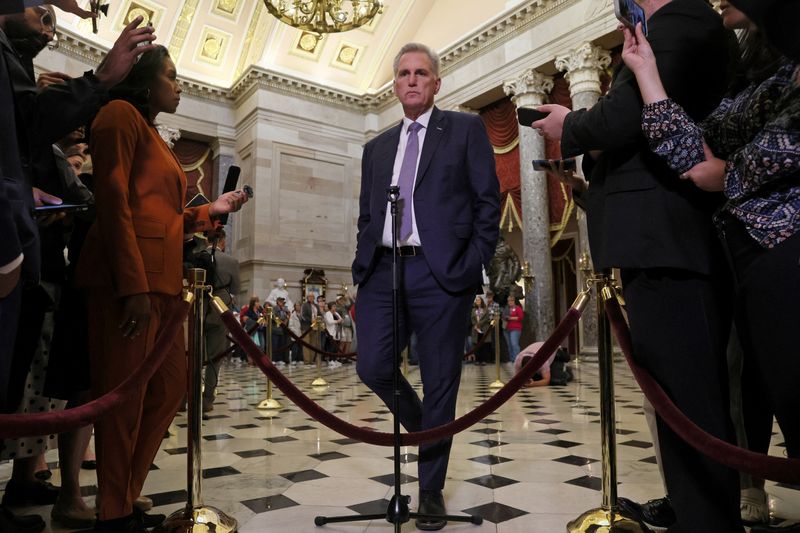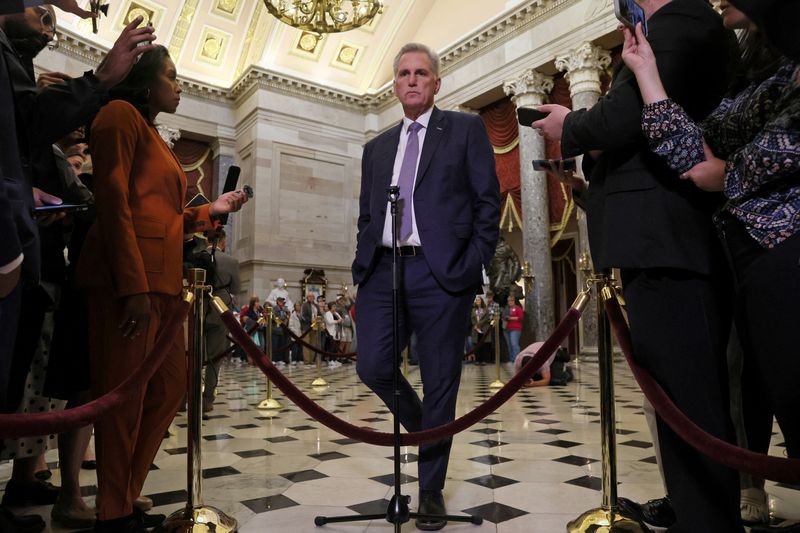Economy
Shutdown countdown: US Congress has four days to fund government


© Reuters. FILE PHOTO: U.S. House Speaker Kevin McCarthy speaks to members of the media as the deadline to avert a government shutdown approaches on Capitol Hill in Washington, U.S., September 26, 2023. REUTERS/Leah Millis
By Moira Warburton, David Morgan
WASHINGTON (Reuters) -Republican U.S. House Speaker Kevin McCarthy on Wednesday rejected a stopgap funding bill advancing in the Senate, bringing Washington closer to its fourth partial shutdown of the U.S. government in a decade in just four days.
That would lead to the furlough of hundreds of thousands of federal workers and the suspension of a wide range of government services, from economic data releases to nutrition benefits, until Congress manages to pass a funding bill that President Joe Biden, a Democrat, would sign into law.
The Senate plan, which advanced on a wide bipartisan margin on Tuesday, would fund the government through Nov. 17, giving lawmakers more time to agree on funding levels for the full fiscal year beginning Oct. 1.
McCarthy’s House of Representatives was focusing its efforts on trying to agree on more of the 12 separate full-year funding bills, of which they have so far passed one.
“I don’t see the support in the House” for the Senate plan, McCarthy said, though the bill has the support of Senate Republicans, including Minority Leader Mitch McConnell.
“The president should step in and do something about it; otherwise the government will shut down,” McCarthy told reporters.
The House was expected to vote late into the night on amendments to specific funding bills, though even if all four of those bills were to be signed into law by Saturday, on their own they would not be enough to prevent a partial government shutdown.
Weeks ago, Biden urged Congress to pass a short-term extension of fiscal 2023 spending, along with emergency aid to help state and local governments cope with natural disasters and help Ukraine in its war against Russia. He also sought new border security funding.
The standoff has begun to attract the attention of ratings agencies, with both Moody’s (NYSE:) and Fitch warning it could damage the federal government’s credit-worthiness.
House Republicans want much tougher legislation that would stop the flow of immigrants at the U.S. southern border with Mexico and deeper spending cuts than were enacted in June.
CALL FOR BIPARTISANSHIP
Executive branch agencies were already making preparations for determining which federal workers would remain on the job — without pay until the government is funded — and which ones will be furloughed. Similar exercises were occurring in Congress as well, where thousands of legislative aides and other support workers are employed.
“Speaker McCarthy, the only way – the only way out of a shutdown is bipartisanship,” Senate Majority Leader Chuck Schumer said in a speech to the Senate.
The Senate its bill also would appropriate about $6 billion for domestic disaster responses and another $6 billion in new aid to Ukraine.
McCarthy is facing threats from hardline members of his own party who rejected a deal he negotiated with Biden in May for $1.59 trillion in discretionary spending in fiscal 2024 and approved in June, demanding instead another $120 billion in cuts.
A handful of the hardliners have also threatened to oust McCarthy from his leadership role if he passes a spending bill that requires any Democratic votes to pass.
McCarthy said House Republicans would probably bring their own stopgap measure to the floor on Friday.
It was unclear whether there will be the votes in the House to win passage of it, however.
The standoff comes four months after Washington flirted with defaulting on the nation’s more than $31 trillion in debt, a move that would have rocked financial markets worldwide.
Another downgrade of the U.S. credit rating could push borrowing costs – and the nation’s debt – even higher.
Hardline Republicans, including Donald Trump, frontrunner for the party’s 2024 presidential nomination, have dismissed the risks of a shutdown and in some cases actively pushed for one.
“My advice is buckle up — there’s turbulence ahead,” Representative Andy Ogles told reporters after attending a closed-door meeting of fellow Republicans.
Economy
Russian central bank says it needs months to make sure CPI falling before rate cuts -RBC


© Reuters. Russian Central Bank Governor Elvira Nabiullina attends a news conference in Moscow, Russia June 14, 2019. REUTERS/Shamil Zhumatov/File Photo
MOSCOW (Reuters) – Russia’s central bank will need two to three months to make sure that inflation is steadily declining before taking any decision on interest rate cuts, the bank’s governor Elvira Nabiullina told RBC media on Sunday.
The central bank raised its key interest rate by 100 basis points to 16% earlier in December, hiking for the fifth consecutive meeting in response to stubborn inflation, and suggested that its tightening cycle was nearly over.
Nabiullina said it was not yet clear when exactly the regulator would start cutting rates, however.
“We really need to make sure that inflation is steadily decreasing, that these are not one-off factors that can affect the rate of price growth in a particular month,” she said.
Nabiullina said the bank was taking into account a wide range of indicators but primarily those that “characterize the stability of inflation”.
“This will take two or three months or more – it depends on how much the wide range of indicators that characterize sustainable inflation declines,” she said.
The bank will next convene to set its benchmark rate on Feb. 16.
The governor also said the bank should have started monetary policy tightening earlier than in July, when it embarked on the rate-hiking cycle.
Economy
China identifies second set of projects in $140 billion spending plan


© Reuters. FILE PHOTO: Workers walk past an under-construction area with completed office towers in the background, in Shenzhen’s Qianhai new district, Guangdong province, China August 25, 2023. REUTERS/David Kirton/File Photo
SHANGHAI (Reuters) – China’s top planning body said on Saturday it had identified a second batch of public investment projects, including flood control and disaster relief programmes, under a bond issuance and investment plan announced in October to boost the economy.
With the latest tranche, China has now earmarked more than 800 billion yuan of its 1 trillion yuan ($140 billion) in additional government bond issuance in the fourth quarter, as it focuses on fiscal steps to shore up the flagging economy.
The National Development and Reform Commission (NDRC) said in a statement on Saturday it had identified 9,600 projects with planned investment of more than 560 billion yuan.
China’s economy, the world’s second largest, is struggling to regain its footing post-COVID-19 as policymakers grapple with tepid consumer demand, weak exports, falling foreign investment and a deepening real estate crisis.
The 1 trillion yuan in additional bond issuance will widen China’s 2023 budget deficit ratio to around 3.8 percent from 3 percent, the state-run Xinhua news agency has said.
“Construction of the projects will improve China’s flood control system, emergency response mechanism and disaster relief capabilities, and better protect people’s lives and property, so it is very significant,” the NDRC said.
The agency said it will coordinate with other government bodies to make sure that funds are allocated speedily for investment and that high standards of quality are maintained in project construction.
($1 = 7.1315 renminbi)
Economy
Russian central bank says it needs months to make sure CPI falling before rate cuts -RBC


© Reuters. Russian Central Bank Governor Elvira Nabiullina attends a news conference in Moscow, Russia June 14, 2019. REUTERS/Shamil Zhumatov/File Photo
MOSCOW (Reuters) – Russia’s central bank will need two to three months to make sure that inflation is steadily declining before taking any decision on interest rate cuts, the bank’s governor Elvira Nabiullina told RBC media on Sunday.
The central bank raised its key interest rate by 100 basis points to 16% earlier in December, hiking for the fifth consecutive meeting in response to stubborn inflation, and suggested that its tightening cycle was nearly over.
Nabiullina said it was not yet clear when exactly the regulator would start cutting rates, however.
“We really need to make sure that inflation is steadily decreasing, that these are not one-off factors that can affect the rate of price growth in a particular month,” she said.
Nabiullina said the bank was taking into account a wide range of indicators but primarily those that “characterize the stability of inflation”.
“This will take two or three months or more – it depends on how much the wide range of indicators that characterize sustainable inflation declines,” she said.
The bank will next convene to set its benchmark rate on Feb. 16.
The governor also said the bank should have started monetary policy tightening earlier than in July, when it embarked on the rate-hiking cycle.

 Forex3 years ago
Forex3 years agoForex Today: the dollar is gaining strength amid gloomy sentiment at the start of the Fed’s week

 Forex3 years ago
Forex3 years agoUnbiased review of Pocket Option broker

 Forex3 years ago
Forex3 years agoDollar to pound sterling exchange rate today: Pound plummeted to its lowest since 1985

 Forex3 years ago
Forex3 years agoHow is the Australian dollar doing today?

 Cryptocurrency3 years ago
Cryptocurrency3 years agoWhat happened in the crypto market – current events today

 World3 years ago
World3 years agoWhy are modern video games an art form?

 Commodities3 years ago
Commodities3 years agoCopper continues to fall in price on expectations of lower demand in China

 Economy3 years ago
Economy3 years agoCrude oil tankers double in price due to EU anti-Russian sanctions

























